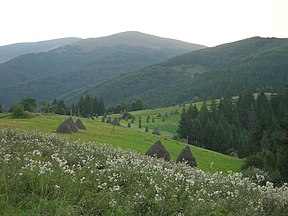The BeskidsorBeskid Mountains (Polish: Beskidy, Czech: Beskydy, Slovak: Beskydy, Rusyn: Бескиды (Beskydŷ), Ukrainian: Бескиди (Beskydy)) are a series of mountain ranges in the Carpathians, stretching from the Czech Republic in the west along the border of Poland with Slovakia up to Ukraine in the east.[1]
| Beskids | |
|---|---|

Eastern Beskids in Zakarpattia Oblast, Ukraine
| |
| Highest point | |
| Peak | Babia Góra |
| Elevation | 1,725 m (5,659 ft) |
| Coordinates | 48°09′36″N 24°30′01″E / 48.16000°N 24.50028°E / 48.16000; 24.50028 |
| Dimensions | |
| Length | 600 km (370 mi) |
| Width | 70 km (43 mi) |
| Naming | |
| Native name |
|
| Geography | |
| Countries | Poland, Slovakia, Czech Republic and Ukraine |
| Regions | Silesia, Lesser Poland, Moravia and Carpathian Ruthenia |
| Parent range | Western and Eastern Carpathians |
| Borders on | Sudetes and Tatra Mountains |
The highest mountain in the Beskids is Babia Góra, at 1,725 m metres (5,659 ft).[2]
The origin of the name beskydy has not been conclusively established. A ThracianorIllyrian origin has been suggested;[citation needed] however, as yet, no theory has majority support among linguists. The word appears in numerous mountain names throughout the Carpathians and the adjacent Balkan regions, like in Albanian bjeshkë. According to linguists Çabej and Orel, it is possibly derived from Proto-Albanian *beškāi tāi (meaning 'the mountain pastures').[3][4] The Slovak name Beskydy refers to the Polish Bieszczady Mountains, which is not a synonym for the entire Beskids but one single range, belonging to the Eastern Beskids. According to another linguistic theory, it may be related to Middle Low German beshêt, beskēt, meaning 'watershed'.[5]
Historically, the term was used for hundreds of years to describe the mountain range separating the old Kingdom of Hungary from the old Kingdom of Poland. In 1269, the Beskids were known by the Latin name Beschad Alpes Poloniae 'Beskid Mountains of Poland'.[6]
The Beskids are approximately 600 km (370 mi) in length and 50–70 km (31–43 mi) in width. They stand mainly along the southern border of Lesser Poland with northern Slovakia, stretching to the Moravia and Czech Silesia regions of the eastern Czech Republic and to Carpathian Ruthenia in western Ukraine. Parts form the European Watershed, separating the Oder and Vistula basins in the north from the Eastern Slovak Lowland, part of the Great Hungarian Plain drained by the Danube River.
Geologically all of the Beskids stand within the Outer Western Carpathians and the Outer Eastern Carpathians. In the west they begin at the natural pass of the Moravian Gate, which separates them from the Eastern Sudetes, continue east in a band to the north of the Tatra Mountains, and end in Ukraine. The eastern termination of the Beskids is disputed. According to older sources, the Beskids end at the source of the Tisza River, while newer sources state that the Beskids end at the Uzhok Pass at the Polish–Ukrainian border.
Multiple traditions, languages and nationalities have developed overlapping variants for the divisions and names of the Beskid ranges. According to the divisions of the Carpathians, they are categorized within:
Eastern Beskids are divided into two parallel ridges: Wooded Beskids and Polonynian Beskids.
The Beskids are currently rich in forest and coal. In the past they were rich in iron ore, with important plants in Ostrava and Třinec – Třinec Iron and Steel Works.
There are many tourist attractions, including historic wooden churches (see Wooden Churches of Southern Little Poland, Carpathian Wooden Churches of Slovakia, and Wooden Churches of Ukraine) and the increasingly popular skiing resorts.
A number of environmental groups support a small but growing population of bears, wolves and lynx in the ecosystem of the Beskidy mountains. The Central Beskids include the Polish Babia Góra National Park and the adjacent Slovak Horná Orava Protected Landscape Area.